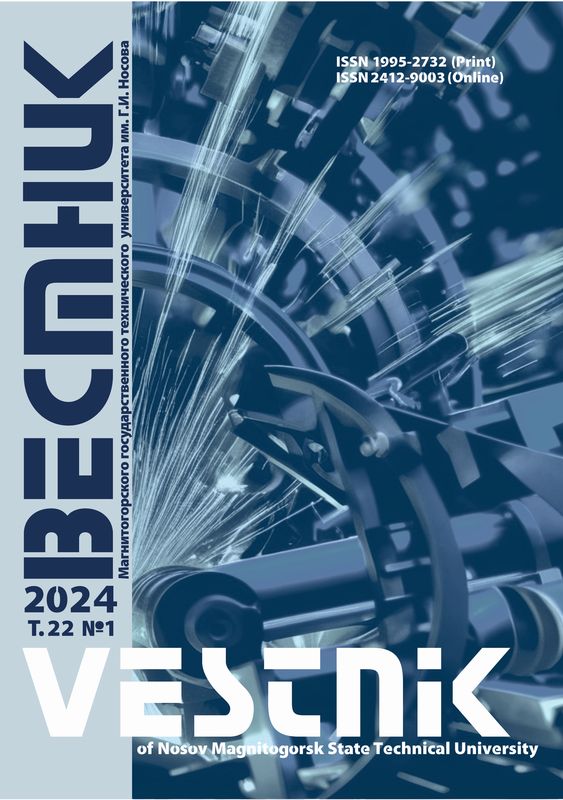DOI: 10.18503/1995-2732-2020-18-1-31-39
Abstract
Problem Statement: Due to a reduced number of the developed tungsten deposits, Russian Federation is facing an urgent issue related to the recycling of tungsten-containing waste by using an efficient waste carbide recycling technique in order to reduce imports of tungsten raw materials, mainly from China. Objectives: To find optimum conditions that would make the carbide recycling process more efficient and cost-effective for manufacturers of carbide products. Originality: This study helped identify the process parameters affecting the process efficiency and confirm the applicability of the developed process, which is designed to turn real carbide waste into powder that can be used to produce new carbide products. The findings show that, in order to avoid the formation of “idle” zinc, it is recommended to reach the temperatures of 850–950°C in a decomposition reactor and inert gas in the pressure range from 0.5 to 1 atm should be used for the heating process, whereas the distillation and destruction processes should take place in vacuum at 4--5 Pa for 5–10 minutes. The vacuum creates an anti-oxidation environment and ensures the required degree of distillation. Findings: With the help of the developed recycling process and the corresponding reactor, carbide material can be completely decomposed at the rate 4-8 times higher than through any of the known alternative techniques and with minimum power consumed. Practical Relevance: Implementation of this process in our country will allow us to boost the efficiency of waste carbide recycling and thus reduce the imports of tungsten raw materials from other countries, mainly from China.
Keywords
Carbide materials, disposal, decomposition, waste recycling technology.
For citation
Trotsenko I.G., Gerasimenko T.E., Alkatsev V.M., Evdokimov S.I. Optimised Waste Carbide Recycling Technology. Part 2. Finding Optimum Implementation Conditions. Vestnik Magnitogorskogo Gosudarstvennogo Tekhnicheskogo Universiteta im. G.I. Nosova [Vestnik of Nosov Magnitogorsk State Technical University]. 2020, vol. 18, no. 1, pp. 31–39. https://doi.org/10.18503/1995-2732-2020-18-1-31-39
1. V.M. Burtsev, A.S. Vasiliev, O.M. Deev et al. Tekhnologiya mashinostroeniya. V 2-kh t. T.2. Proizvodstvo mashin [Engineering technology. In 2 volumes. Vol.2. Machine building]. Moscow: MGTU im. N.E. Baumana, 2001, 640 p. (In Russ.)
2. State report “On the Status and Use of Mineral Resources of the Russian Federation in 2016 and 2017”, Moscow, 2018. (In Russ.)
3. Kozin L.F., Trefilov V.I. Rare metal industry of Ukraine. Problems and prospects. Preprint. NAN Ukrainy, IPM NANU, IONKh NANU, Kiev, 1997. 74 p. (In Russ.)
4. Bord N.Yu., Korolevich S.V., Khonyak K.V. New recycling technology for solid and heavy waste alloys. Instrument [Tool], 1997, no. 6, p. 10. (In Russ.)
5. Zelikman A.N., Kasparova T.V., Binder S.I. Preparation of carbides from regenerated WC-Co mixtures obtained from lumpy waste by zinc method. Tsvetnye Metally [Non-ferrous metals], 1993, no. 1, pp. 47–49. (In Russ.)
6. Zharkov D.V., Zykus M.Yu., Medvedev A.S., Fisenkov M.V. Sposob pererabotki kuskovykh otkhodov tvordykh splavov [A method for processing lumpy carbide waste]. Patent RF, no. 2101375, 1998.
7. Paul G. Barnard, Heine Kenworthy. Reclamation of refractory carbides from carbide materials. Patent US, no. 3595484, 1971.
8. X. Liu, S. Xu, K. Wang. Recycling of WC-Co alloys. Non-Ferrous Metals, 2003, vol. 55, no 3, pр. 59–61.
9. Dvornik M.I., Ershova T.B. Sposob pererabotki otkhodov tvordogo splava VK8 elektroerozionnym dispergirovaniem [A method for processing the waste VK8 carbide by electroerosion dispersion]. Patent RF, no. 2443507, 2012.
10. Trotsenko I.G., Svistunov N.V. Sposob pererabotki kuskovykh otkhodov tvordykh splavov [A method for processing lumpy carbide waste]. Patent RF, no. 2276193, 2006.
11. Alkatsev M.I., Guriev V.R. Sposob pererabotki kuskovykh otkhodov tvordykh splavov [A method for processing lumpy carbide waste]. Patent RF, no. 2189402, 2002.
12. Ageev E.V., Semenikhin B.A. Utilization of carbide waste by electroerosion dispersion. XV Mezhdunarodnaya nauchno-prakticheskaya konferentsiya studentov, aspirantov i molodykh uchenykh “Sovremennye tekhnika i tekhnologii” [15th International Conference of Students and Young Researchers “Advanced Machinery and Technology”], Tomsk, 4-8 May 2009. Tomsk, 2009. (In Russ.)
13. Malyshev V.V., Gab A.I. Resource-saving methods for recycling waste tungsten carbide-cobalt cermet and extraction of tungsten from tungsten concentrates. Theoretical Foundations of Chemical Engineering. 2007. Vol. 41. No 4. Pp. 436–441.
14. Malyshev V.V., Soloviev V.V., Lukashenko T.F. et al. Environmentally friendly and resource-saving methods for recycling waste tungsten carbide-cobalt alloys and extraction of tungsten from tungsten concentrates. Vestnik KrNU im. M. Ostrogradskogo [Bulletin of Ostrogradskiy Kremenchug National University], vol. 4, 2011 (69), P.1, pp. 155–159.
15. Kolobov G.A., Panov V.S. New technologies for the processing of tungsten and carbide wastes. Zaporozhskaya gosudarstvennaya inzhenernaya akademiya. Metallurgiya [Zaporizhia State Engineering Academy. Metallurgy], 2013, no. 1, pp. 65–73. (In Ukr.)
16. Pee Jae Hwan, Yun Jin Soon, Cho Woo Seok, Kim Kyung Ja, Seong Nam Eui. Recycling method of tungsten carbide from waste cemented carbide using pressured zinc melt. Patent KR, no. 20120028490, 2012.
17. Xiahou Bin. Method for recycling tungsten carbide and metallic cobalt through waste tungsten-cobalt cemented carbide. Patent CN, no. 106145114, 2016.
18. Trotsenko I.G., Svistunov N.V. Apparat dlya pererabotki otkhodov tverdykh splavov tsinkovym sposobom [A device for processing carbide waste by zinc method]. Patent RF, no. 2341571, 2008.
19. Pivovarov M.N., Vlasova A.V. A new method for processing lumpy carbide waste. Novaya tekhnologiya [New technology], 2003, no. 1, pp. 89–91. (In Russ.)
20. Panov V.S., Chuvilin A.M., Falkovskiy V.A. Tekhnologiya i svoystva spechennykh tverdykh splavov i izdeliy iz nikh [Technology and properties of sintered hard alloys and products made with them]. Moscow: MISiS, 2004, 463 p. (In Russ.)
21. Trotsenko I. G., Gerasimenko N.P. Sposob pererabotki kuskovykh otkhodov tverdykh splavov [A method for processing lumpy carbide waste]. Patent RF, no. 2643291, 2018.
22. Trotsenko I.G. Reaktor destruktsii otkhodov tverdykh splavov gazoobraznym tsinkom [A reactor for carbide waste decomposition with gaseous zinc]. Patent RF, no. 2581690, 2016.
23. Khimicheskiy entsiklopedicheskiy slovar [Chemical Encyclopedic Dictionary]. Editor-in-chief: I.L. Knunyants. Moscow: Soviet Encyclopedia, 1983, 792 p. (In Russ.)
24. Aynshteyn V.G., Zakharov M.K., Nosov G.A. et al. Obshchiy kurs protsessov i apparatov khimicheskoy tekhnologii [General course in chemical processes and equipment]. In 2 volumes. Vol. 1. Moscow: Khimiya, 1999, 888 p. (In Russ.)












